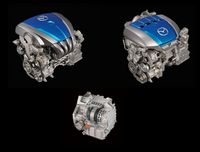Mazda Embarks on a 'Green' Fleet Revolution
DARTFORD, UNITED KINGDOM – March 25, 2010:A ‘green’ revolution is being staged by Mazda that will mean upper medium sector company car drivers by 2015 will be at the wheel of models with fuel economy and emissions equivalent to today’s supermini standards.
Improved aerodynamics, retuned powertrains, a concerted focus on reducing vehicle weight and the gradual introduction of sophisticated new technologies such as i-stop (Smart Idling Stop System) will all contribute to delivering first-class environmental and MPG performance for all Mazda vehicles.
This fuel-sipping, emissions-busting technology known as SKYTECH aims to achieve a 30 percent improvement in average fuel economy over the 2008 level for all Mazda cars sold globally by 2015, but fleets can start to expect to benefit from the breakthrough technology in less than two years time.
Fuel economy and carbon dioxide emission levels are directly linked, so improvements in petrol and diesel consumption will deliver reduced CO2 emissions. While other manufacturers press on with hybrid and alternative fuel solutions, Mazda’s short term focus is to significantly improve efficiencies delivered through a traditional internal combustion engine platform. This is likely to be delivered at a lower investment than required in hybrid development but deliver the same CO2 and fuel economy benefits as the hybrid vehicles.
Taken together, those benefits translate into significant financial savings for fleet decision-makers and company car drivers alike in terms of vehicle operating costs, reduced fuel bills and savings in vehicle-related taxes including: capital allowances, Vehicle Excise Duty and Class 1A National Insurance contributions for businesses and benefit-in-kind tax for drivers.
Mazda has already embarked on its ‘green’ crusade with today’s key fleet models such as the Mazda3 and Mazda6 reflecting the environmental strategy. For example, CO2 levels on the Mazda3 are already at 119g/km on 1.6D models and at sub-150g/km on the Mazda6 2.2D.
Mazda Fleet and Remarketing Director Peter Allibon said: “Our existing customers are already benefiting from the first phase of our environmental strategy.
“The first vehicles from the SKYTECH programme we expect to start reaching fleets in 2012. The indications are that the emission levels on some Mazda C/D segment models will drop below 100 g/km, while all models will be below 120 g/km.
“While Mazda is working behind the scenes on technological alternatives to petrol and diesel engines with research and development on hydrogen vehicles continuing apace, we expect that the internal combustion engine will remain the dominant and economic choice for fleets and company car drivers into the foreseeable future.”
That view was recently echoed in a major report by leading contract hire and fleet management company Leasedrive Velo. The study, ‘A vision of fleet management in 2015. Predictions on how the fleet industry could look in the future’, concluded that petrol and diesel-engined company cars would remain the vehicles of choice.
Mazda predicts that its SKYTECH technology will mean tomorrow’s petrol-engined models delivering fuel economy equivalents to that of current models that are one class smaller. For example, the Mazda6 could deliver average fuel economy of around 45mpg - a 10mpg improvement on today’s levels.
Fuel economy improvements are predicted to be even greater on future Mazda diesel models with engineers forecasting Mazda C/D segment models returning almost 70mpg - equivalent to today’s Mazda2 1.4D and 1.6D models with CO2 levels around the 100 g/km mark.
The third strand of Mazda’s ‘green’ revolution features the introduction of a new six-speed automatic transmission that will deliver a further five percent fuel economy improvement to models compared with the current five-speed transmission.
Mr Allibon added: “Fleets and drivers are flocking to Mazda in increasing numbers due to the sporty design and performance of our range and its well positioned list price. When those fleets and drivers replace their existing Mazda company cars from 2012 onwards they will see significant performance and environmental improvements to what is already a multi-award winning vehicle line-up.
“The focus that our engineers have on improving the environmental performance of Mazda models means that I anticipate that we and our existing customers will be business partners for many years to come.”



